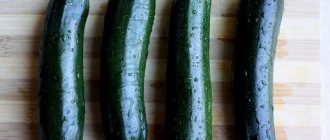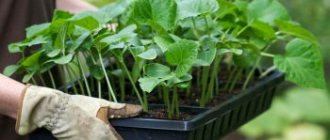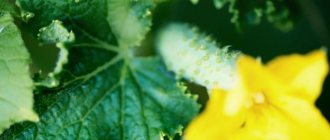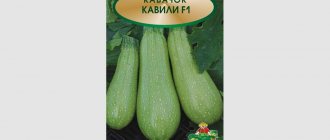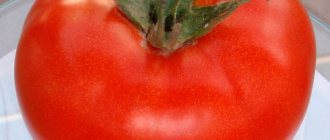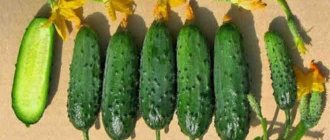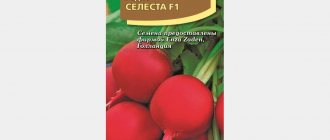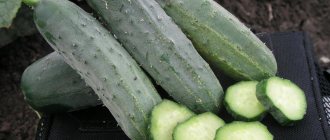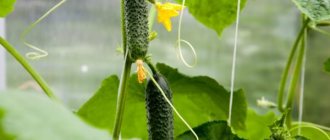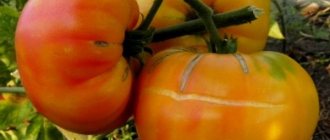Zucchini hybrids are always in demand among summer residents due to their qualities enhanced by selection. Read about one of the most common varieties in our article.
Zucchini variety Iskander
Iskander zucchini leaves spotted
Pale green zucchini fruits
Description and characteristics of the Iskander F1 variety
In recent years, the Dutch hybrid Iskander F1 has become increasingly popular. Excellent productivity, unpretentiousness and early ripening puts it among the leaders among zucchini.
Growing region
The result of modern selection is expanding the geography of zucchini plantings. Iskander will feel great both in the Central part of Russia and in the Far Eastern region, will not be afraid of the short Siberian summer and will delight the Urals and Volga region with its fruits. Initially, it was included in the State Register of Breeding Achievements of Russia in the Lower Volga region for open ground.
Appearance
The plant is compact, powerful and bushy. Green leaves with pronounced spotting are large, medium dissected.
The fruits of Iskander F1 are soft green with small light specks. They are small, club-shaped, tapering at the stalk. The marketable weight ranges from 500-700 g; the length of the zucchini rarely reaches more than 20 cm. The thin peel with a barely noticeable waxy coating is easily removed with a knife.
Productivity and area of application of fruits
Iskander F1 is famous for its high productivity: maximum yields reach 916 c/ha or up to 17 kg per bush.
The yield of the variety is almost 2 times higher than the standard of Gribovskie 37 zucchini!
The early ripeness of the variety allows for excellent harvests within 40-50 days after planting. Greenhouses and covered beds will allow vegetables to ripen even faster. The end of fruiting comes only with the first frost. Due to its excellent yield and unpretentiousness, zucchini is recommended for industrial cultivation.
The unsurpassed taste of Iskander remains throughout the entire season. The pulp is creamy white, dense and tender. The variety is used for table purposes and does not lose its properties when frozen and preserved.
For a video review of the Iskander zucchini variety, see the following video:
Resistance to diseases and pests
The variety has good resistance to common zucchini diseases. To maintain disease resistance, prevention is best: maintaining crop rotation, maintaining optimal humidity levels, regular weeding and loosening. Repeated plantings and planting in the ground after or next to representatives of pumpkin plants are unacceptable.
Advantages of the variety
All gardeners in their reviews note the excellent yield of this zucchini. One bush can produce up to 17 kilograms. The long period of fruiting, which ends with the arrival of the first frost, also provides the variety with first place among its “comrades.”
The early ripening period (from germination to maturity should take a little more than 40 days) allows you to harvest the first harvest at the end of spring or at the very beginning of summer.
Iskander zucchini is resistant to diseases such as powdery mildew and anthracosis.
Planting and growing zucchini Iskander F1
There are two main ways to plant zucchini:
- seedling;
- planting seeds in the ground.
Let's look at each of them in more detail.
Seedling method
The seedling method is more labor-intensive and expensive, but you will enjoy the first harvest 2-3 weeks earlier. Sowing seedlings begins about a month before active work in the garden.
Seed preparation
Preparing seeds for seedlings is carried out in the following order:
- soaking in a growth-stimulating solution for up to 24 hours;
- storing seeds in a wet cloth for 24-48 hours at a temperature of 22-24 degrees.
In hybrid varieties, self-collection of seeds is impossible. It is better to buy high-quality material for sowing from trusted suppliers.
Sowing seeds for seedlings
For active plant growth, it is advisable to use fertilized soil. Peat, manure, and humus are suitable additives.
You can prepare your own growing medium for seedlings. For this you will need:
- sawdust 1 part;
- peat 5 parts;
- humus 5 parts;
- 0.5 cups of ash and 5 g of ammonium nitrate per 10 liters of mixture.
It is best to plant seeds in peat molds, because young zucchini do not like transplanting. Or, when planting in open ground, transport the plants along with the soil so as not to injure the roots.
Planting containers are filled with prepared soil and watered; the seeds are planted to a depth of 3-4 cm.
Seedling care
Caring for seedlings includes watering, fertilizing and maintaining favorable temperature conditions. Before the sprouts appear, the ideal temperature will be 18-25 degrees, after 17-20 degrees during the day and 13-15 at night. Watering the seedlings is carried out exclusively with warm water once every 5-7 days.
During the growth of the plant, you can fertilize 2 times - a week after germination, then after the same period of time. For the first time, prepare a solution at the rate of 0.5 tsp. urea per liter of water with a consumption of 0.5 cups per plant. Second time - 1 tsp. nitrophoska per liter, consumption - 200-250 ml per sprout.
Transplantation of seedlings into the ground occurs after the end of frost, when the plant has already grown 2-3 true leaves.
Planting seeds in the ground
Prepared seeds are planted immediately in the soil, but strictly in well-warmed soil - the temperature at a depth of 5-6 cm is not lower than 8-10 degrees. Germination will largely depend on the location and quality of the soil.
Selecting a location
The main factor when choosing a planting site is the quality of the soil. The ideal option would be light soil with neutral acidity on the sunny side. Groundwater should not be too close, and the soil needs to be well warmed throughout the entire period of plant growth.
Ideally, sowing will take place after potatoes, onions, nightshades or legumes.
Soil preparation
Zucchini, like any vegetables, loves fertile soil, so fertilizing is extremely important for a high yield. But before carrying out it, it is important to consider the type of soil. For example, acidic soil should be alkalized, but for neutral soil, fertilizers are sufficient.
For maximum effect, alkalization is carried out in the fall.
Options for fertilizing the soil in the table:
| Soil type | Type of fertilizer per 1 sq. m |
| Sandy | Peat or turf 10 kg and 2 kg of sawdust or compost, a handful of ash |
| Clay/loam | 2-3 kg of peat or turf and compost or sawdust, a handful of ash |
| Peat | 10 kg of turf or compost, a handful of ash, 15-20 g of potassium sulfate and superphosphate |
Planting scheme
To ensure adequate plant nutrition, it is recommended to follow a planting pattern of 150-200×60-70 cm.
Holes 15-20 cm deep and about 30 cm wide are prepared for seedlings, the seeds are planted to a depth of 4-6 cm. They are watered abundantly and a mixture of humic fertilizer and azofoska is added.
Seedlings are transplanted into open ground in the evening or in cloudy weather.
Is it necessary to make seedlings?
When planted in open ground or a greenhouse with seeds, the Iskander F1 variety squash produces excellent seedlings and ripens quickly, so seedlings are usually not made if the product is grown for personal consumption. If the vegetable is needed for sale, you can prepare seedlings, but preferably in peat cups, since young plants of this species do not like replanting.
You can prepare seedlings, but preferably in peat cups, since young plants of this species do not like replanting
They begin to grow seedlings from the beginning of March, so that within a month they can be transplanted into a greenhouse or greenhouse. If the crop is cultivated directly in the open air, harvesting should be postponed until mid-April. It is grown for 1 month, then transplanted into separate holes. If the seedlings are weak, you can plant 2 sprouts in each hole, rather than one at a time, just to be on the safe side.
Features of caring for Iskander F1 zucchini
Iskander F1 is a very unpretentious variety, but proper care and care will allow you to get a maximum harvest of excellent quality.
Watering
Zucchini tolerates dry weather well, but for full growth and development, watering of about 20 liters per bush is required. It is especially important at the beginning of the growing season, when the plant is just gaining strength.
To carry out watering, it is necessary to ensure that the soil dries out; on average, 1-2 times a week will be enough. It is produced with warm water directly on the soil under the root to avoid rot on the leaves and ovary.
Top dressing
Regular application of fertilizers increases the yield by 40-50%. 3 feedings per season are considered optimal:
- if there are 3-4 true leaves;
- at the beginning of the appearance of the ovary:
- during fruiting.
The first addition of additives is carried out with the following mixture: 20 g of ammonium and potassium nitrate, 40 g of superphosphate per bucket of water. A good option would be to add a solution of chicken manure (1 to 20) or mullein (1 to 10) in a volume of 2 liters per plant.
For the second and third feeding, the nutritional composition is prepared from 50 g of superphosphate and 50 g of potassium nitrate per bucket of water.
Zucchini does not like chlorine-containing fertilizers.
Spraying
Spraying zucchini has 2 goals:
- increasing resistance to pests and diseases;
- attracting insects for better pollination.
To increase the plant's immunity, folk remedies can be used for spraying: infusions of onion and garlic peels, tobacco infusion or a solution of ash and soap.
To attract pollinators, a sweetened solution is used: 5 g of boric acid is dissolved in a bucket of water, sugar is added. This option is relevant for greenhouse zucchini.
Loosening, weeding and mulching
Loosening the soil will increase its capacity for moisture, air and heat. But special care will be required due to the zucchini roots being close to the surface. Mulching with peat and humus will simplify this task.
Weeding is carried out as the weeds grow. You need to pay special attention to them during the period of active plant growth. Afterwards, large zucchini leaves will begin to clog the growth of other plants, and the bed will remain almost clean.
Harvest and storage
Iskander's early ripeness makes it possible to harvest the first vegetables within 40-45 days after germination. Remove zucchini from the bush in dry weather 2-3 times a week. An unusual feature of the variety is that the higher the harvest, the more new ovary.
Well-ripened vegetables can be stored in the basement for up to 6 months at temperatures up to +10 degrees. Ripeness is easy to check: the peel becomes harder and cannot be scratched, and the sound when tapped is dull.
The taste of Iskander F1 is preserved when preserved and frozen.
Harvest and storage
Harvesting should be done once every 2 weeks or more often until the fruits reach ripeness. If you collect zucchini more often, this will ensure the appearance of new ovaries. Moreover, the weather must be dry at this time. It is important not to overexpose the fruits on the bushes; they should not be wet after rain or from dew.
The harvested fruit should be stored in the refrigerator so that various dishes can be prepared. The hybrid variety Iskander is also intended for further processing, canning, drying or freezing.
Pests and diseases
Zucchini may suffer from diseases or pests. The main signs of damage and methods of control are given in the table:
| Disease/pest | Signs of defeat | Treatment |
| Anthracnose | Growing light spots on the leaves, the foliage turns brown and dries out. | Removing diseased parts, spraying with Bordeaux mixture. |
| Powdery mildew | Powdery white coating with a tendency to increase the affected area. | Treatment with mullein or hay infusion. |
| Gray rot | Growing areas of rotting on ovaries and flowers. | Soil replacement, phosphorus fertilizers, removal of affected areas, reasonable crop rotation. |
| Downy mildew | Light spots on the leaves, leading to browning and drying out. | Removing diseased parts, spraying with Bordeaux mixture. |
| Spider mite | Numerous light spots, the leaf turns yellow and dies. | Removing diseased leaves, spraying with tincture of hot pepper. |
| melon aphid | Affected flowers, ovaries and leaves dry out and die. | Removal and burning of diseased parts of the bush, treatment with karbofos. |
| Whitefly | Infection with sooty fungi, leaves die. | Treatment with Confidor or Fosbecid. |
Reviews of Iskander F1 zucchini
★★★★★
Mikhail, 35 years old, engineer, Voronezh. The variety came across by chance when purchasing seeds.
I planted only 2 out of 5 seeds, both sprouted. The one that grew near the fire in the garden pleased with a large harvest. Surprisingly it did not succumb to garden ants. And how good it is sliced and fried in a pan! I definitely recommend it. ★★★★★
Nadezhda, 45 years old, housewife, Rostov-on-Don. I really love Iskander for its early ripening, I plant it every year.
We collect the last harvest in late autumn. It tastes simply wonderful, and is also a friend to those losing weight! I recommend to everyone! Hide
Add your review
High-yielding, early ripening, unpretentious, tender, persistent - all this is about the hybrid zucchini Iskander F1. Treat yourself to delicious vitamins from the garden without making a huge effort.
0
0
Copy link
